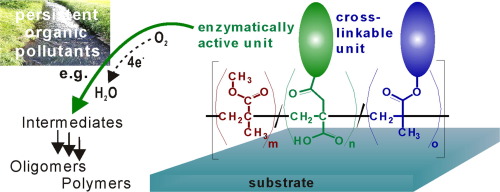当前位置:
X-MOL 学术
›
Eur. Polym. J.
›
论文详情
Our official English website, www.x-mol.net, welcomes your
feedback! (Note: you will need to create a separate account there.)
Multifunctional crosslinkable itaconic acid copolymers for enzyme immobilization
European Polymer Journal ( IF 5.8 ) Pub Date : 2018-05-01 , DOI: 10.1016/j.eurpolymj.2018.03.014 Felix Müller , Bernhard Torger , Peter J. Allertz , Klaus Jähnichen , Stefan Keßler , Martin Müller , Frank Simon , Katrin Salchert , Haike Mäurer , Doris Pospiech
European Polymer Journal ( IF 5.8 ) Pub Date : 2018-05-01 , DOI: 10.1016/j.eurpolymj.2018.03.014 Felix Müller , Bernhard Torger , Peter J. Allertz , Klaus Jähnichen , Stefan Keßler , Martin Müller , Frank Simon , Katrin Salchert , Haike Mäurer , Doris Pospiech

|
Abstract UV-Crosslinkable itaconic copolymers are developed to provide new multifunctional materials for coatings which combine crosslinkable functionalities and the possibility to immobilize enzymes. The polymer-immobilized enzymes were used for water treatment to decompose persistent organic molecules. Introduction of suitable comonomers allows tailoring the mechanical and chemical properties for special applications. Copolymers containing MMA and itaconic anhydride were chosen because of the formation of long-term stable anhydride functionalities. These anhydride functionalities are employed to attach enzymes covalently. 4-Benzoylphenyl methacrylate is used as comonomer for UV-initiated crosslinking. Terpolymers are successfully obtained by radical copolymerization in solution. The copolymers are compared to poly(ethylene-alt-maleic anhydride) [P(EMA)] often used with respect to enzyme immobilization, activity and hydrolytic stability. The hydrolysis stability of the copolymers against water is studied by ATR-FTIR spectroscopy. Thin films are prepared on glass substrates in a layer-by-layer procedure by spin-coating. The layer formation is monitored by ATR-FTIR spectroscopy. UV-crosslinking of the copolymer films is performed taking the optimal irradiation dose that avoids polymer degradation. ATR-FTIR spectroscopy verifies the coupling reaction between amino groups of the enzyme and the anhydride groups on the surface of the crosslinked polymer film. The syringaldazine (4-hydroxy-3,5-dimethoxybenzaldehyde azine) test and 2,2′-azino-bis(3-ethylbenzothiazoline-6-sulphonic acid) (ABTS) assay demonstrate that the immobilized enzymes maintain their activities. The functional copolymers showed a significant effect in reduction of persistent organic pollutants in contaminated waste water.
中文翻译:

用于酶固定的多功能可交联衣康酸共聚物
摘要 UV-可交联衣康共聚物旨在为涂料提供新的多功能材料,该材料结合了可交联功能和固定酶的可能性。聚合物固定化酶用于水处理以分解持久性有机分子。引入合适的共聚单体可以为特殊应用定制机械和化学性能。选择含有 MMA 和衣康酸酐的共聚物是因为形成了长期稳定的酸酐官能团。这些酸酐官能团用于共价连接酶。4-苯甲酰苯基甲基丙烯酸酯用作紫外线引发交联的共聚单体。通过在溶液中自由基共聚成功地获得了三元共聚物。将共聚物与聚(乙烯-alt-马来酸酐)[P(EMA)] 相比,在酶固定化、活性和水解稳定性方面经常使用。通过ATR-FTIR光谱研究共聚物对水的水解稳定性。薄膜是通过旋涂在玻璃基板上逐层制备的。通过ATR-FTIR光谱监测层形成。共聚物薄膜的紫外线交联采用避免聚合物降解的最佳辐照剂量进行。ATR-FTIR 光谱验证了酶的氨基与交联聚合物薄膜表面的酸酐基团之间的偶联反应。丁香醛连氮(4-羟基-3,5-二甲氧基苯甲醛吖嗪)试验和2,2'-azino-bis(3-ethylbenzothiazoline-6-sulphonic acid) (ABTS) 测定表明固定化酶保持其活性。功能共聚物在减少受污染废水中的持久性有机污染物方面显示出显着效果。
更新日期:2018-05-01
中文翻译:

用于酶固定的多功能可交联衣康酸共聚物
摘要 UV-可交联衣康共聚物旨在为涂料提供新的多功能材料,该材料结合了可交联功能和固定酶的可能性。聚合物固定化酶用于水处理以分解持久性有机分子。引入合适的共聚单体可以为特殊应用定制机械和化学性能。选择含有 MMA 和衣康酸酐的共聚物是因为形成了长期稳定的酸酐官能团。这些酸酐官能团用于共价连接酶。4-苯甲酰苯基甲基丙烯酸酯用作紫外线引发交联的共聚单体。通过在溶液中自由基共聚成功地获得了三元共聚物。将共聚物与聚(乙烯-alt-马来酸酐)[P(EMA)] 相比,在酶固定化、活性和水解稳定性方面经常使用。通过ATR-FTIR光谱研究共聚物对水的水解稳定性。薄膜是通过旋涂在玻璃基板上逐层制备的。通过ATR-FTIR光谱监测层形成。共聚物薄膜的紫外线交联采用避免聚合物降解的最佳辐照剂量进行。ATR-FTIR 光谱验证了酶的氨基与交联聚合物薄膜表面的酸酐基团之间的偶联反应。丁香醛连氮(4-羟基-3,5-二甲氧基苯甲醛吖嗪)试验和2,2'-azino-bis(3-ethylbenzothiazoline-6-sulphonic acid) (ABTS) 测定表明固定化酶保持其活性。功能共聚物在减少受污染废水中的持久性有机污染物方面显示出显着效果。











































 京公网安备 11010802027423号
京公网安备 11010802027423号